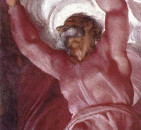Separation of Light from Darkness (c. 1508-1512) is a painting in fresco that is on the ceiling of the Sistine Chapel in Vatican, Rome. It is the first in the series of nine central panels that run along the center of Michelangelo's Sistine Chapel ceiling and which depict scenes from the Book of Genesis. In the painting, the image of God is framed by four ignudi and by two shields or medallions. The ignudi are young, nude males are painted as supporting figures at each corner of the five smaller narrative scenes along the center of the ceiling. Although the meaning of these figures is subject to debate, they are generally considered to represent day and night, which echo the theme of light and darkness. There are a total of 20 ignudi in the painting of various postures
The Separation of Light from Darkness is one of five smaller scenes that alternate with four larger scenes that run along the center of the Sistine ceiling. The painting is based on verses 3-5 from the first chapter of the Book of Genesis:
- 3: And God said, "Let there be light," and there was light.
- 4: God saw that the light was good, and He separated the light from the darkness.
- 5: God called the light "day," and the darkness he called "night." And there was evening, and there was morning—the first day.
- Part of Speech: proper noun
- Industry/Domain: Arts & crafts
- Category: Murals & decorative painting
Other terms in this blossary
Creator
- Xena
- 100% positive feedback
(Los Angeles, United States)



